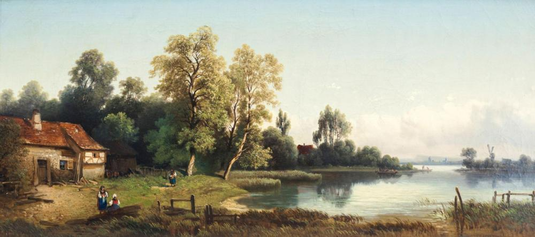Winter in Holland
|
Research by Susan Auty and Ivan Midgley
|
|
Acc No 3
Artist Julius Bayer Artist dates 1840 -1883 Medium oil on canvas Size 67.9 x 105.4 cm (26.8 x 41.5 in) Date painted circa 1874 Donor John Broadbent of Manchester Date donated March 1931 Notes: Typewritten label on stretcher 'Boyer 16 Winter in Holland' Also on stretcher - two foreign canvas stamps and stencilled numbers '25 2 40' Frame label says: Winter in Holland by J Bayer presented to the Borough of Lytham St Annes March 1931 by John Broadbent Esquire of Manchester Also donated Acc No 35 'Landing the Catch' by A J Bennett |
 River Landscape with a Farmhouse and Figures by Julius Bayer River Landscape with a Farmhouse and Figures by Julius Bayer
ARTIST
Julius Bayer, who specialised in landscape painting, was the son of Anton Bayer, also a painter. He was born in Modling in 1840, one of six children. After attending the Realsschule he became a student at the Vienna Academy - studying under Griepenkerl during 1855-56 - and the Landscape School between 1864 and 1866. From 1869 Boyer became a member of the Vienna Artists' House, where he exhibited regularly from 1874. Julius Bayer's paintings were typical examples of the Dutch Romanticism movement. The international Romantic movement, which had swept across Europe, arrived late in the Netherlands. Landscape painting then took centre stage in Dutch Romanticism and was based mainly on a revaluation of Dutch 17th century landscapes and came to dominate Dutch painting for about 70 years. Andreas Schelfhour (1787-1870) was a early adherent to this movement. His Dutch winter scenes and frozen canals with skaters were already famous during his lifetime. Nicholaas Johannes Roosenboom (1805-1880) was also a leading and successful Romantic painter who collaborated with, amongst others, the Belgian animal painter, Eugene Joseph Verboeckhoven (1798-1881), whose painting Cattle and Sheep in a Landscape, is also part of the Lytham St Annes Art Collection. Bayer settled in Salzburg in 1880, where he died in 1883, leaving a wife, Theresia Bayer, and two children. He is buried in Salzburg Municipal Cemetery. PAINTING The composition of Winter in Holland is very pleasing, with an approximate one-third, two-thirds split both vertically and horizontally. The sky reflects the monochrome of winter but with a suggestion of warmth in the yellows. Given the remnants of leaves on the trees it is probably early winter. The ice towards the near bank looks barely frozen enough for skating. There is very relaxed movement in the painting with no evidence of a stiff wind despite the clouds. This is reflected in the casual posture of the villagers who have taken advantage of the icy conditions to venture onto the ice to enjoy skating and sledging. The cottages are in a distinctive Dutch style, low with fairly steep roof caps and a pitched roof on the gable end. In the far distance it is possible to glimpse a windmill and two ships, moored on the right hand bank, indicating that the ocean is not far away. The effect of the undefined clouds and the sketchy figures is very impressionistic. |

